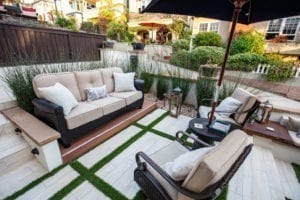Softscaping is the art of creating a lush and inviting landscape using plants, trees, shrubs, and other organic elements. When done right, softscaping can transform any outdoor space into a natural oasis that soothes the senses and provides a haven of relaxation.
In this comprehensive guide, we will explore the best plants for softscaping, taking into account factors such as climate, soil type, and maintenance requirements to help you design the garden of your dreams.
1. Consider Your Climate
Before diving into plant selections, it’s crucial to consider your local climate. Plants that thrive in one climate may struggle in another. Understanding your climate zone will be instrumental in choosing the right plants for your softscape.
a. Tropical Paradise
- Palm trees: For a touch of the tropics, palm trees like the Areca Palm or Sago Palm can create a lush, exotic atmosphere.
- Hibiscus: Known for their vibrant, large blooms, hibiscus varieties are perfect for adding a splash of color.
b. Mediterranean Beauty
- Lavender: These aromatic, drought-tolerant plants are ideal for Mediterranean-inspired gardens.
- Olive trees: Olive trees add a timeless, rustic charm to any landscape.
c. Woodland Wonderland
- Ferns: Native ferns like the Maidenhair or Lady Fern bring a delicate, feathery touch to woodland settings.
- Rhododendrons and Azaleas: Their colorful blooms and evergreen foliage thrive in the shade.
2. Soil Matters
The type of soil in your garden plays a significant role in plant selection. Conduct a soil test to determine its pH and nutrient content, and choose plants that thrive in your soil type.
a. Sandy Soil
- Succulents: Drought-tolerant succulents like Sedum and Agave flourish in well-draining sandy soils.
- Beach Grasses: Sea oats and beach grasses help stabilize sandy soils and provide a coastal look.
b. Clay Soil
- Daylilies: These hardy perennials thrive in clay soil and offer a burst of color.
- Black-eyed Susans: These native flowers are adaptable and can handle clay soil.
c. Loamy Soil
- Roses: The rich, loamy soil is perfect for roses of all varieties.
- Hostas: These shade-loving plants thrive in loamy soil and provide lush greenery.
3. Maintenance Levels
Consider your available time and effort for garden maintenance when selecting plants for softscaping. Some plants require more care and attention than others.
a. Low Maintenance
- Ornamental Grasses: Grasses like Fountain Grass and Maiden Grass add texture and require minimal care.
- Succulents: Their water-storing capacity means they can go for extended periods without watering.
b. Moderate Maintenance
- Hydrangeas: These shrubs require regular pruning and moisture but reward with stunning blooms.
- Japanese Maple: Regular pruning and attention to soil quality are needed for these ornamental trees.
c. High Maintenance
- Roses: Pruning, disease control, and regular feeding are essential for rose bushes.
- Orchids: These indoor plants demand specific humidity levels and precise care.
4. Biodiversity and Wildlife
To create a thriving ecosystem in your softscape, incorporate plants that attract pollinators and support local wildlife.
a. Butterfly and Bee-Friendly
- Butterfly Bush: This plant attracts butterflies with its fragrant blooms.
- Bee Balm: As the name suggests, it’s a favorite of bees and hummingbirds.
b. Bird Attractors
- Native Berries: Plants like serviceberry and elderberry produce berries that birds love.
- Evergreen Trees: Trees like pine and spruce provide year-round shelter for birds.

Softscaping is a delightful way to create a harmonious and inviting outdoor space in your home using carefully selected plants. By considering your climate, soil type, maintenance levels, and biodiversity, you can create a garden that not only looks beautiful but also thrives in harmony with nature. So, get your gardening gloves on and start planning your softscape masterpiece today!
To explore more, check out 12 Essential Tools Every DIY Landscaper Should Have.



